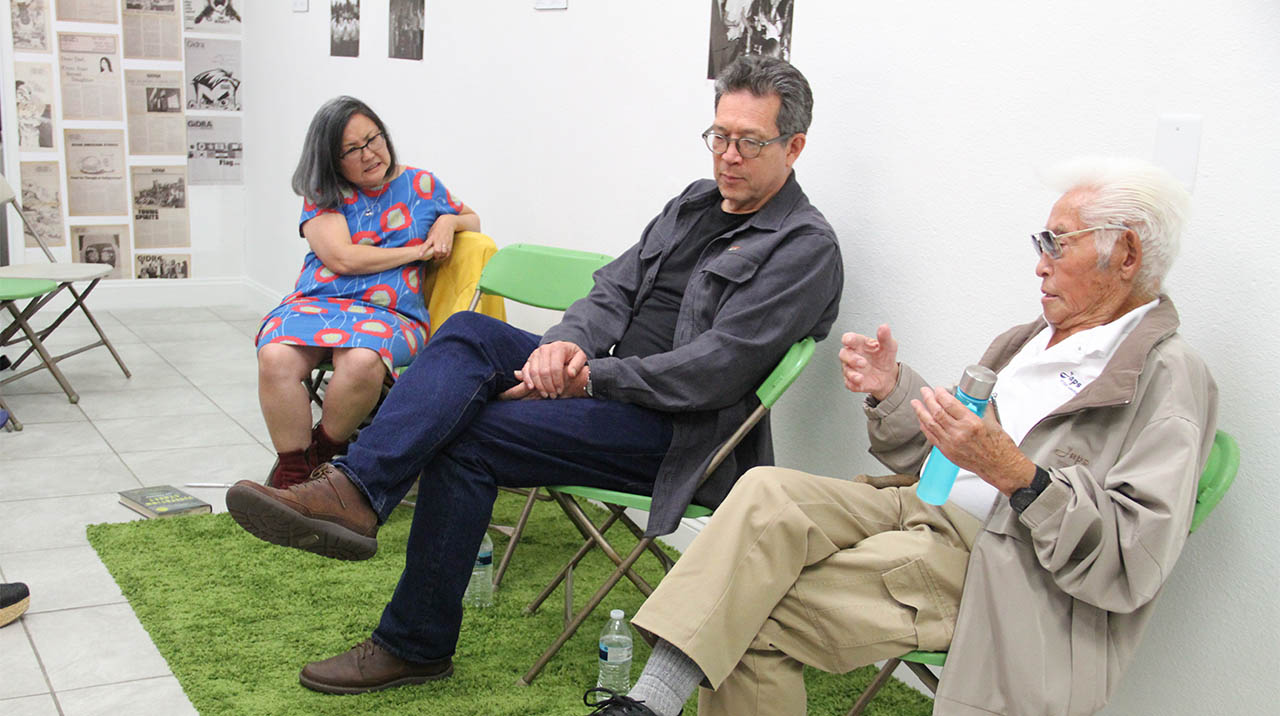Visual Communications Pulls Off "Centering the Masses" at 341 FSN
/341FSN, the venue for Visual communications’ “Centering the Masses.” (photo: josaen ronquillo/visual communications photographic archive)
By Abraham Ferrer
NINE WEEKS…
To be sure, a “pop-up” series was something that Visual Communications has never tried at any time throughout its forty-nine year history. And at first blush, a nine-week residency in a Little Tokyo storefront crammed with an eclectic assortment of programs — from film screenings, photographic exhibits, artist talks, literary meet-ups, filmmaker boot-camps and book launches, to even live podcast recording sessions — would seem overwhelming to even the most hearty and intrepid of audience members and event organizers alike.
Yet from April 5 through May 30, 2019, Visual Communications succeeded by pulling off a remarkable, impactful series of programs in the heart of historic Los Angeles Little Tokyo as the unofficial kick-off to its year-long prelude to the organization’s Golden Year Anniversary in 2020. The pop-up series, CENTERING THE MASSES, celebrated the ideals of “community” as it pertains to Little Tokyo and its population of denizens and “stakeholders”; and sought to interrogate the many factors that endanger it.
This groundbreaking series was inspired by +LAB, a place-based creative initiative of the Little Tokyo Service Center (LTSC), and Sustainable Little Tokyo (SLT), a community-driven outreach and engagement initiative of the Japanese American Cultural & Community Center, Little Tokyo Community Council, and Little Tokyo Service Center. Recognizing the need for a physical space to allow Little Tokyo area artists the opportunity to engage audiences in meaningful ways, LTSC and SLT’s Arts Action Committee secured the former Matsumura Gifts storefront located on the ground level of the refurbished Daimaru Hotel along historic First Street North and created 341FSN, inspired by the #MyFSN (for “My First Street North”) hashtag campaign initiated in 2018. Since March of 2018, 341FSN has hosted a wide variety of events organized by groups including the JACCC, LTSC, and up-and-coming collectives such as Japanese American Women Speak (JAWS) and Changing Tides. Seeing the opportunity to utilize 341FSN to re-frame the ongoing conversation around a new round of community redevelopment concerns, Visual Communications conceived CENTERING THE MASSES as a means of exploring the impact of new “threats” to Little Tokyo — a new subway station, the prospect of new market-rate housing with little or no consideration for low-income residents, the influx of a new community of residents with little to no appreciation for Little Tokyo’s history or values — as well as to celebrate and affirm the values and heritage of the neighborhood.
47 PROGRAMS…
Working with a quartet of hand-picked curators — Walt Louie, Naomi Hirahara, Yuri Shimoda, and Marvin Yueh — Visual Communications employed a decentralized approach to programming its take-over of the 341FSN storefront. Walt, a film and television editor who also serves on VC’s Board of Directors, chose to resurrect MONDAY NITE VC, a successful artist-and-talk series that he organized and presented at VC from 1998 through 2001. Naomi, a former Rafu Shimpo English-language editor-turned-mystery novelist, was interested in creating a mini-series bringing in writers and novelists with at-times conflicting viewpoints about Los Angeles and its many denizens. Marvin, a radio producer who additionally oversees the Los Angeles chapter of the APA talent incubator organization Kollaboration, pulled together a three-part live podcast series inspired by his work producing shows as a lead producer of the Potluck Podcast Collective. And Yuri, a recent graduate of UCLA’s Masters’ of Library and Information Sciences program, organized a community-themed photographic exhibit culled from images from VC’s Photographic Archive, which served as a prelude of sorts to the large-scale VC Founders’ photographic exhibit, AT FIRST LIGHT: THE DAWNING OF ASIAN PACIFIC AMERICA, which opened in May at the Japanese American National Museum.
The “decentralized” programming approach was complemented with direct invitations to community groups including the UCLA Asian American Studies Center, Nikkei Progressives, WAPOW, and Asian and Pacific Islander Americans in Historic Preservation to curate and organize single-day programs reflecting their own philosophical and community priorities. This more collegial approach to curation and programming produced an eclectic slate of programs that marshaled both advocacy and technology in the service of investigating the different definitions and expressions of “community.”
For instance, take the UCLA Asian American Studies Center, invited to develop single-day programs to serve as a prelude for its own upcoming 50th anniversary activities. UCLA AASC brought to Little Tokyo two of its current core programs: “Building History 3.0,” an interactive session that encouraged participants to construct the incarceration experience at Manzanar using Minecraft computer software; and a community filmmaking bootcamp led by instructors and teaching assistants from the Center for Ethnocommunications.
Or how about Nikkei Progressives? This recently-formed organization, composed partly of veteran members of Nikkei for Civil Rights & Redress, packed 40 visitors into 341FSN on a Mother’s Day afternoon to learn about a former Japanese American internment camp in Crystal City, TX that is being repurposed into a detention center for migrants and asylum seekers.
Finally, consider longtime VC supporter and Digital Histories instructor Joel Quizon, who curated a unique movie-and-music happening, RE-SCORED: A FILM AND MUSIC PERFORMANCE that took place off-site at the Tateuchi Democracy Forum, right around the corner from 341FSN, and organized a standing-room-only screening of BEATS, RHYMES, AND RESISTANCE as part of a memorial tribute to the late academic/activist/preservationist Dawn Mabalon, which occurred in conjunction with the 35th Los Angeles Asian Pacific Film Festival. For programs like these, “celebration” and “catharsis” went hand-in-hand.
When taken in context with the curated mini-series MONDAY NITE VC: REWIND, the literary mini-series BULL & PUPPY, and the remote podcast series LUCHA LA MIC, it became quite apparent that the Visual Communications crew had created something special — a multi-week, cross-genre series that wasn’t quite a festival, per se. Instead, CENTERING THE MASSES served to re-position Little Tokyo as a “meeting-point” where friends, strangers, allies, and antagonists alike meet.
TWO EXHIBITIONS…
Yuri Shimoda, whose VC internship during the 2018-2019 academic year was centered around creating and implementing an indexing and data gathering system for the VC Archives’ collection of 35mm color slides, organized a photo exhibit, OUT OF THE SHADOWS: BUILDING COMMUNITY THROUGH THE ARTS, composed of images from VC’s Asian Pacific Photographic Archive. The exhibit, which hung on the walls of 341 FSN throughout the run of the pop-up series, included images made by other key members of Visual Communications whose impact may be somewhat less celebrated but whose images succeeded in filling in some sizeable gaps in telling the overall story of the growth of an Asian Pacific American community. Prominent among those additions were the photos of Ed Ikuta, whose images observing both profound and ordinary goings-on in the then-Asian American communities of greater Los Angeles provided a necessary complement to the iconic images made by VC Founders Duane Kubo, Robert Nakamura, Alan Ohashi, and Eddie Wong.
In a curator’s talk that took place on Opening Weekend, Yuri and Ed highlighted the importance of documenting scenes of the every-day lives of APA communities to present a nuanced picture of a “movement,” and also observed the evolution in camera technology and how access to digital equipment might have altered the habits of an old-school VC photographer — Ed quipped that these days, he makes photographs primarily on his iPhone. His photos, many of which were curated into OUT OF THE SHADOWS, speaks pointedly to the effects of casting an eye on subjects otherwise deemed unworthy of spotlighting in a photo exhibit, never mind being important enough to document.
The walls of 341FSN were also grace with a “Wall of Tribute” composed of the sixty-six covers of the Asian American political vernacular Gidra that were produced between 1969 through 2001. Intended as a tribute to the influential newsmagazine on the occasion of its 50th anniversary year, the Gidra “Wall of Tribute” turned out to be a popular backdrop for numerous “selfies” and photo opportunities for guest artists and visitors alike. It also provided a chance to ponder the growth and maturation of a socio/political movement through print media and the written word in all its various forms.
NEARLY ONE-THOUSAND ATTENDEES, AND UNTOLD MINDS BLOWN…
Coming as it did as the tail-end of a year that affirmed 341FSN as a space in which arts in all its forms could indeed instigate positive change, CENTERING THE MASSES provided Visual Communications with the chance to conceive and execute an extended, concentrated public program series — something the organization had never attempted before. Of the nearly 1,000 guests who attended various programs throughout the nine-week run of the series, over half had never actually visited Little Tokyo on any other occasion than the pit-stop for ramen or related foodie gatherings. Even more still were largely unaware of the current threats to Little Tokyo by way of gentrification, which afforded the opportunity for Visual Communications and its series allies to talk deeply and intimately about the changes happening outside the doors of 341FSN, and to link those developments and threats to the various programs offered throughout the nine-week series.
At times, the conversation arising from various programs was somewhat intense. The program REAWAKENING CAPACITY IN COMMUNITY DEVELOPMENT turned into a strategy session allowing WAPOW representatives and their allies to assess coalition-building efforts in the wake of drastic gentrification issues visiting L.A. Chinatown; while Nikkei Progressives’ crowded FAMILIES BELONG TOGETHER event provided a chilling prelude to the current plans by the White House to incarcerate migrant children at a former WWII internment center at Fort Sill, Oklahoma. As a whole, the conversations arising from the various CENTERING THE MASSES programs proved valuable in providing a much-needed platform to celebrate “community” in all its forms, and afforded a greater understanding of the history of Little Tokyo and its neighboring communities as well as the factors that threaten its continued viability as a living, working community.
So, what next? The presentation of CENTERING THE MASSES represents the finale of 341FSN as an experimental artists and community space, as it is expected to be leased to an outside business by year’s end. However, the momentum generated by Visual Communications and the various grassroots organizations that activated the space has resulted in much-welcome dialogue on issues that matter most to Little Tokyo’s stakeholders and concerned visitors. We hope and expect that whenever and wherever such programs are next mounted, the momentum and inventiveness continues.
A visitor to “centering the masses” views the gidra “wall of tribute” at 341fsn. (photo: Josaen Ronquillo/visual communications photographic archive)
CENTERING THE MASSES was proudly supported through funds provided by the George and Sakaye Aratani Foundation, CalHumanities, the City of Los Angeles’ Department of Cultural Affairs, the Historic Cultural Neighborhood Council – Little Tokyo, and +LAB – a place-based arts initiative of the Little Tokyo Service Center. In-kind support was provided by Primo Water, whose ubiquitous “healthy hydration station” at 341FSN was a welcome sight for all.
A special “thank you” goes to our curators — Walt Louie, Naomi Hirahara, Yuri Shimoda, and Marvin Yueh, and representatives of our partner organizations including Janet Chen, Barbra Ramos, Meg Thornton, and Karen Umemoto (UCLA Asian American Studies Center), Kathy Masaoka, Tony Osumi, Jan Tokumaru, and Janice Yen (Nikkei Progressives), Wendy Chung (WAPOW), and Michelle Magalong (Asian and Pacific Islander Americans in Historic Preservation) for their inspiration and invention in bringing a far-ranging scope of ideas and program topics to 341FSN for the community at-large to engage and learn from.
Additional thanks to LTSC’s Mitsuko Brooks for her help and advice in making 341FSN “work” for VC staff to mount such an ambitious series; to Kristin Fukushima of the Little Tokyo Community Council and Sustainable Little Tokyo’s Scott Oshima for being such staunch allies; and finally to all the countless artists and audiences whose participation and presence affirmed the larger goals and purpose of CENTERING THE MASSES.











































